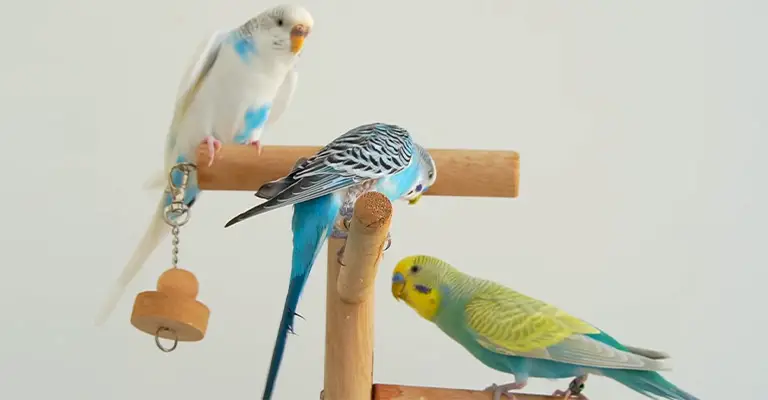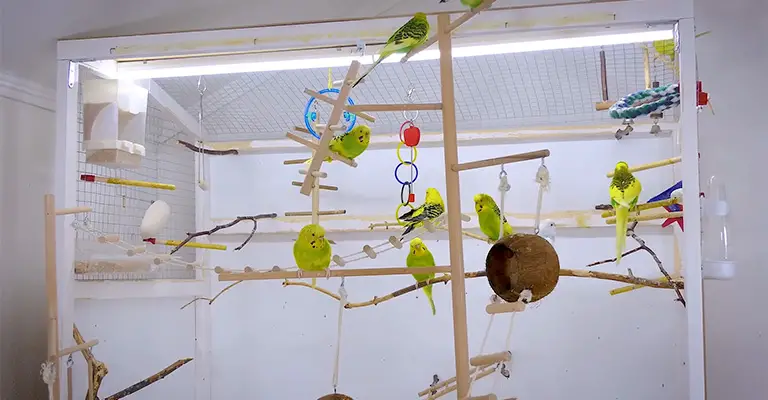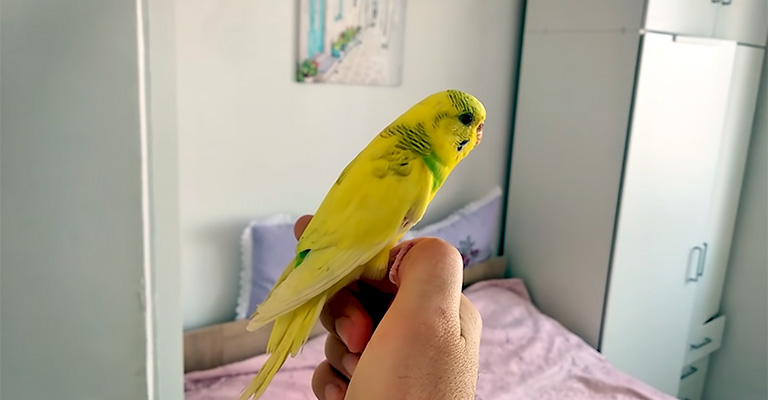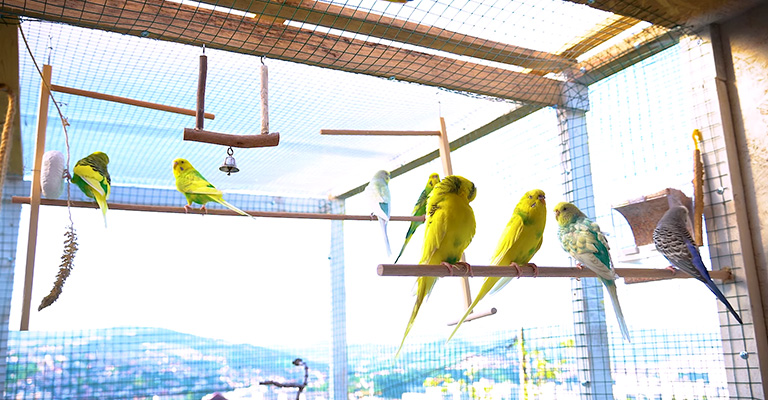Budgies, those charming and vibrant little parakeets, have captured the hearts of bird enthusiasts around the world. As these feathered companions flutter around their cages, showcasing their playful antics and colorful plumage, a common question arises: Are budgies messy birds?
The answer, like their dynamic personalities, is not as straightforward as one might think. In this exploration, we delve into the intriguing world of budgie behaviors, shedding light on whether these delightful creatures can truly be labeled as messy.
From their seed-scattering tendencies to their fondness for bathtime splashes, we’ll uncover the factors that contribute to their perceived messiness. As we navigate through the feathers, seeds, and joyful chirps, we’ll unveil the realities of budgie messiness.
Whether you’re a seasoned budgie owner or considering bringing these enchanting birds into your life, join us in demystifying the notion of budgies as messy companions.

Are Budgies Messy Birds?
Yes, budgies can be considered messy birds to some extent. Their playful and active nature, along with their feeding and grooming behaviors, can lead to certain levels of mess in their living environment. Here are a few ways in which budgies can contribute to messiness:
Seed Scattering
Budgies tend to pick through their food and scatter seeds around their cage as they eat. This can result in a layer of seeds and hulls on the cage floor.
Feather Shedding
Like all birds, budgies molt and shed feathers. Feather dust and small feathers can accumulate in the cage and surrounding area.
Bathing
Budgies enjoy splashing around in the water for bathing. This can lead to water droplets being flung outside the bathing dish, causing wet spots around the cage.
Chewing and Shredding
Budgies love to chew and shred toys and other objects. This can result in paper, cardboard, or toy parts being scattered around their living space.
Food Flinging
Budgies have a tendency to grab food items and toss them around as they eat. This behavior can result in food particles and crumbs being scattered beyond their feeding area. Budgies naturally defecate, and their droppings can accumulate in the cage and on perches.
Nesting Material
If you provide nesting material, budgies may carry it around, shred it, and sometimes even drop it outside of their nesting box, creating a mess in the cage.
Exploration
Budgies are curious birds and like to investigate their surroundings. They might knock over objects or tip over their food and water dishes during their exploratory endeavors.
Playful Activities
Budgies engage in playful activities that can lead to messiness, such as playing with toys that have bells, bells, or bells. These activities can create noise and sometimes cause small parts to detach.
Cage Lining
If you use cage liners, budgies might scratch or tear them, resulting in small pieces of paper or material being spread around the cage.
Nesting Behavior
In breeding pairs, budgies can be particularly messy when preparing their nesting area. They may strip leaves and bark from branches, leading to debris scattered around the cage.
Water Dispersion
While bathing, budgies can shake their wet feathers, causing water droplets to be flung onto the cage bars and surrounding areas.
While budgies can create some mess, many owners find the joy of their company and their lively behaviors far outweigh the minor inconveniences of cleaning up.
Proper cage setup, regular cleaning routines, and appropriate toys and enrichment can help manage and minimize the mess associated with these charming and engaging birds.
How to Stop Your Budgie from Making a Mess?

While you can’t completely eliminate all messes caused by budgies, you can take steps to manage and minimize their mess-making tendencies. Here are some tips to help reduce messiness:
Choose Cage Accessories Wisely
Opt for spill-resistant food and water dishes to minimize seed scattering and water splashing. Look for toys that are less likely to create debris.
Use Cage Liners
Place cage liners or newspaper at the bottom of the cage to catch falling seeds and droppings. This makes cleaning easier and reduces mess around the cage.
Establish a consistent cleaning schedule. Clean the cage, perches, and accessories regularly to prevent the buildup of debris.
Provide a Bathing Area
Offer a designated area for your budgies to bathe, such as a shallow dish of water. This can help contain the mess created during bathing.
Seed Guards
Consider using seed guards or catchers that attach to the cage to prevent seeds from scattering outside the cage. Use feeders that minimize spillage by preventing budgies from tossing out seeds easily.
Strategic Toy Placement
Place toys strategically to avoid them being knocked over easily. Choose toys that are durable and won’t create a lot of mess when played with.
Limit Nesting Materials
If you’re not breeding budgies, avoid providing excessive nesting materials that can lead to messy behavior.
Supervised Playtime
During playtime outside the cage, monitor your budgies closely. This allows you to intervene if they start creating a mess in your living space.
Train Command Words
Train your budgies to respond to commands like “Step up” or “Go home.” This can help you guide them back to their cage without causing too much disturbance.
Proper Feeding Technique
If your budgies tend to fling food while eating, consider feeding them smaller portions more frequently to minimize the amount of scattering.
Floor Coverings
If your budgies are playing outside the cage, place a designated play area on a floor covered with newspaper or a washable mat to catch debris.
Remember that a certain level of mess is natural and part of budgies’ behaviors. Finding a balance between allowing them to express their natural instincts and maintaining a clean living environment is key.
Regular cleaning and using preventive measures can help you enjoy the companionship of your budgies without feeling overwhelmed by messiness.
Can I Potty Train My Budgie to Minimize Mess?

Potty training a budgie, like other parrot species, is a bit more challenging compared to training dogs or cats.
While it’s not exactly possible to potty train a budgie in the same way, there are some strategies you can try to minimize the mess caused by droppings:
Observation
Pay attention to your budgie’s body language and behavior before they are eliminated. Budgies often assume a specific posture or position before defecating.
Predictable Patterns
Budgies tend to be eliminated shortly after waking up, after eating, and before bedtime. Try placing them in a designated area during these times.
Command Words
Use a simple command word like “potty” or “go poop” when you notice your budgie is about to eliminate. Over time, they might associate this word with the action.
Designated Area
When allowing your budgie out of the cage, place a perch or a piece of newspaper over a designated area where they can be eliminated more easily.
Positive Reinforcement
Offer treats and praise when your budgie is eliminated in the designated area. Positive reinforcement can help them understand that they’re doing something right.
Consistency
Be consistent in your approach. Repeating the same routine and command words can help reinforce the behavior you want.
Keep Sessions Short
When your budgie is out of the cage, keep the sessions relatively short to increase the chances of them being eliminated in the designated area before they return to their cage.
Be Patient
Remember that accidents will happen, and it might take time for your budgie to associate the designated area with elimination.
It’s important to keep in mind that even with these efforts, budgies may not fully understand or consistently respond to potty training like some other pets. Accidents are likely to occur, and it’s part of living with birds.
Regular cleaning and providing a clean living environment are essential to maintain their health and well-being.
How to Clean Your Budgie’s Mess?

Cleaning up after your budgie is an essential part of maintaining a healthy and tidy living environment. Here’s how to effectively clean up their mess:
Daily Cleaning
Remove soiled cage liners or newspaper at the bottom of the cage and replace them with fresh ones. Use a small handheld vacuum or a dustpan and brush to collect fallen seeds and debris around the cage.
Cage Cleaning
Regularly clean and disinfect the cage, perches, and accessories using bird-safe cleaning products. Follow the manufacturer’s instructions.
Remove and wash food and water dishes daily to prevent the buildup of food particles and bacteria.
Bathing Area
If your budgies bathe in a dish, empty and clean the dish after each bath to prevent water residue and potential mold growth.
Play Area
If your budgies have playtime outside the cage, cover the play area with newspaper or a washable mat to catch droppings and debris.
Remove any toys, perches, or accessories that your budgies interacted with during playtime and clean them. Wipe down perches regularly with a damp cloth to remove droppings and debris.
Quick Spot Cleaning
Keep a small handheld vacuum or a lint roller handy for quick spot cleaning of seeds, feathers, and droppings.
Deep Cleaning
Plan for a deep cleaning of the cage and accessories once a week or as needed. This involves removing and thoroughly cleaning each component of the cage.
Odor Control
Maintain proper ventilation in the room to prevent odors from accumulating. Consider placing an air purifier with a HEPA filter to help reduce airborne particles and odors.
Regular Hygiene
Wash your hands before and after handling your budgies to prevent the spread of germs and bacteria.
Be Patient and Thorough
Cleaning up after budgies requires patience and consistency. Regular maintenance will make the process more manageable and prevent the buildup of mess.
Remember that budgies are naturally active and explorative creatures, and some mess is inevitable.
By establishing a cleaning routine and maintaining a hygienic living environment, you can create a comfortable and enjoyable space for both you and your feathered companions.
FAQs
It’s recommended to perform a daily quick clean-up, such as removing soiled cage liners and vacuuming up fallen debris.
A more thorough cleaning, including changing cage liners and disinfecting perches, should be done at least once a week.
Use bird-safe cleaning products or a mixture of water and mild dish soap to clean your budgie’s cage and accessories. Avoid harsh chemicals, as budgies are sensitive to fumes.
Use a handheld vacuum or a lint roller to clean up droppings and seeds from the play area. You can also use a damp cloth to wipe down surfaces and toys.
Proper ventilation and regular cleaning help prevent odors. Using an air purifier with a HEPA filter can also help reduce airborne particles and odors.
While it’s not always necessary to remove your budgies from the cage during daily cleaning, it’s recommended to place them in a safe and secure area during deep cleaning to avoid stress or exposure to cleaning fumes.
Conclusion
While budgies might be associated with certain messy behaviors, their perceived “messiness” is an inherent aspect of their natural behaviors and interactions with their environment.
As social and active birds, they explore, play, and eat in ways that might scatter seeds and create some disarray.
However, understanding these behaviors as part of their vibrant personalities can help foster a more harmonious coexistence. By providing appropriate cages, accessories, and cleaning routines, budgie owners can manage and mitigate the potential mess.
Offering designated play areas and maintaining a consistent cleaning schedule can strike a balance between their exuberance and the desire for a tidy living space.
Embracing the playful antics and joyful chirps of these enchanting birds often outweighs the minor inconveniences of their messiness.
With a blend of patience, adaptation, and a deep appreciation for their unique nature, budgie owners can find themselves immersed in a delightful companionship.